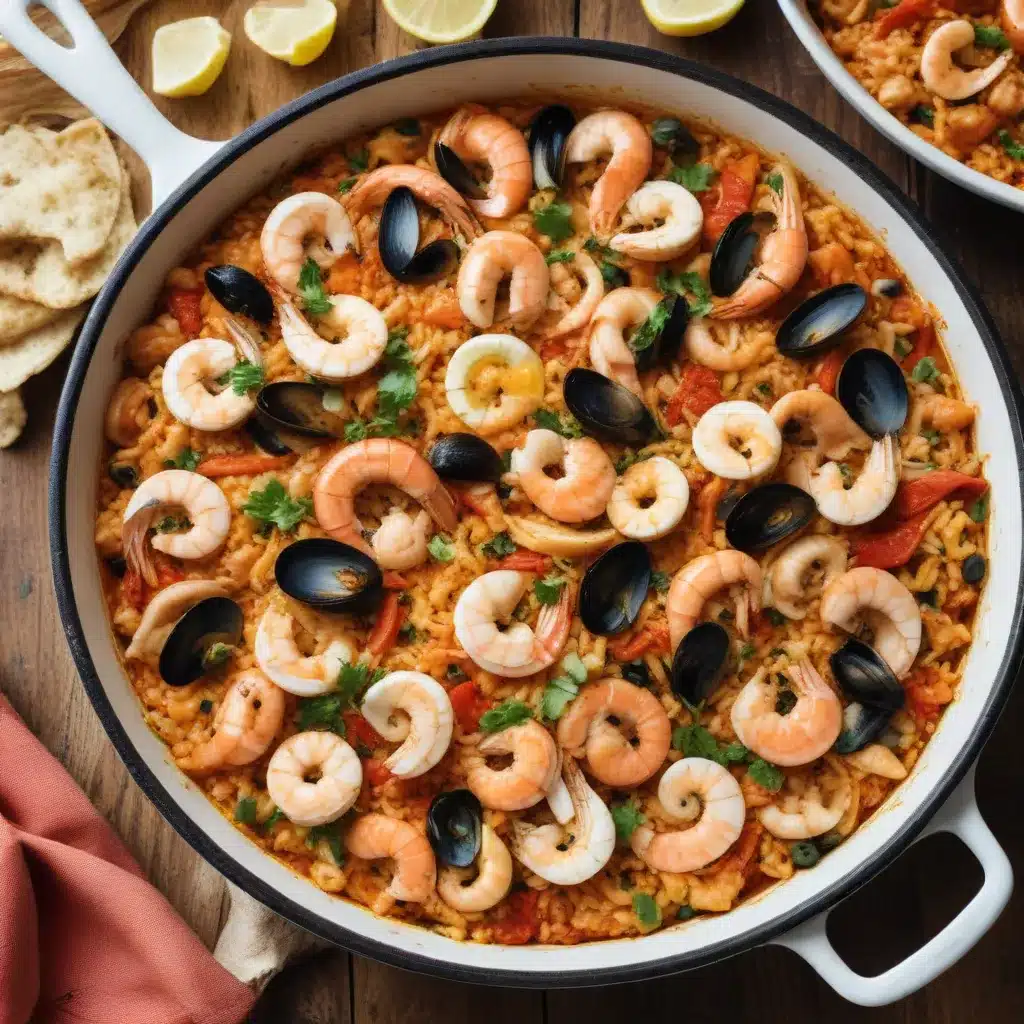
Paella Basics
Paella is an iconic Spanish rice dish originating from Valencia. The name derives from the wide, shallow pan used to cook it over an open fire. While a traditional paella pan is ideal, you can easily prepare this dish in a large skillet or wide, shallow Dutch oven.
The hallmark of paella is the use of short-grain rice, often referred to as bomba or Calasparra. These rices are prized for their ability to absorb liquid and create a signature texture – slightly firm yet creamy. In a pinch, you can substitute arborio rice, a medium-grain variety commonly used for risotto.
Seafood Ingredients
Seafood paella showcases a vibrant variety of ocean treasures. Shrimp, with their sweet, briny flavor and tender-firm texture, are a must-have. Succulent mussels and clams also make frequent appearances, their shells opening to reveal plump, juicy meat. You can customize the seafood selection based on personal preference and availability – scallops, squid, and even fish fillets work beautifully.
The key is to add the seafood in a strategic order, allowing the slower-cooking items like mussels and clams to steam open over the simmering rice before adding the quickly cooked shrimp towards the end.
Vibrant Spanish Flavors
At the heart of paella’s signature flavor profile is the prized spice saffron. Derived from the delicate stigmas of the Crocus sativus flower, saffron imparts a distinctively floral, almost honey-like aroma and a brilliant golden hue to the rice. Sourcing high-quality Spanish saffron is crucial for achieving an authentic paella experience.
Alongside the saffron, a sofrito of aromatic vegetables – onions, garlic, and tomatoes – provides a savory foundation. These ingredients are sautéed until soft and caramelized, infusing the entire dish with their deep, concentrated flavors.
One-Pot Cooking
The beauty of paella lies in its one-pot simplicity. Begin by searing the protein – in this case, chicken and chorizo sausage – to develop a delicious fond (browned bits) on the bottom of the pan. Then, sauté the sofrito vegetables, allowing their flavors to mingle.
Next, stir in the uncooked rice until each grain is coated in the aromatic oil. Pour in a flavorful broth, seasoned with saffron, paprika, and hot sauce. Cover and simmer until the rice has absorbed most of the liquid, but is still slightly undercooked.
Finally, nestle the seafood into the rice, cover, and continue cooking until the mussels and clams have opened and the shrimp are opaque and tender. The result is a harmonious blend of textures and flavors, with the rice developing a coveted crispy socarrat (caramelized bottom layer) that paella enthusiasts cherish.
Signature Dish
Paella is a beloved staple of Spanish cuisine, with countless regional variations. In Valencia, the home of this iconic dish, you’ll find the traditional version made with chicken, rabbit, and locally harvested garrofó (lima) beans. Coastal areas often feature a more seafood-centric paella, while inland regions may incorporate pork or game meats.
Beyond its delicious flavor profile, paella is a cultural centerpiece, often served at celebratory gatherings and enjoyed communally straight from the pan. The ritual of preparing and sharing this bountiful dish has become an integral part of Spanish identity and tradition.
Serving and Presentation
When it comes to serving paella, the presentation is just as important as the flavors. Bring the steaming pan directly to the table, allowing your guests to marvel at the vibrant colors and enticing aromas. Garnish the dish with freshly chopped parsley and lemon wedges, inviting everyone to squeeze the citrus over their servings.
Paella is meant to be enjoyed family-style, with everyone diving in straight from the pan. Provide your guests with forks and encourage them to stir the rice, seafood, and aromatic vegetables together, ensuring each bite is a harmonious blend of flavors and textures.
Health Benefits
Seafood paella is a nutritious and well-balanced meal. The lean protein from the shrimp, mussels, and clams provides essential amino acids, while the antioxidant-rich tomatoes, peppers, and saffron offer a wealth of vitamins and minerals. The whole-grain rice supplies complex carbohydrates and fiber, rounding out the dish with a satisfying dose of sustained energy.
Furthermore, the use of healthy fats like olive oil and the inclusion of vegetables make this a well-rounded, nutrient-dense dish that can be enjoyed as part of a balanced diet. For those adhering to a gluten-free lifestyle, paella is a naturally gluten-free option, making it an excellent choice for inclusive gatherings and meals.
Cooking Techniques
Properly preparing the saffron is crucial for unlocking its full potential. Begin by gently crushing the delicate threads between your fingers to help release their aromatic oils. Then, steep the saffron in a small amount of hot broth or water, allowing it to bloom and infuse the liquid with its vibrant hue and flavor.
When it comes to cooking the rice, the secret lies in the absorption method. Rather than stirring the rice constantly, as you would for risotto, you’ll want to let the grains sit undisturbed, allowing them to gradually absorb the flavorful broth. This technique is key for achieving the coveted socarrat – a delightfully crispy, caramelized layer at the bottom of the pan.
Flavor Profiles
Beyond the saffron, paella derives its signature flavors from a blend of spices and aromatics. Smoked paprika lends a warm, earthy note, while fresh parsley provides a bright, herbaceous contrast. A squeeze of lemon or a drizzle of sherry vinegar at the end brightens the dish, cutting through the richness of the seafood and rice.
These harmonious flavor profiles transport you to the sun-drenched shores of Spain, each bite a celebration of the country’s vibrant culinary heritage. Whether you’re a seasoned paella enthusiast or a newcomer to this captivating dish, this recipe is sure to delight your senses and leave you craving more.
Visit Fish Tales Cafe to explore more seafood-centric recipes and culinary adventures.

